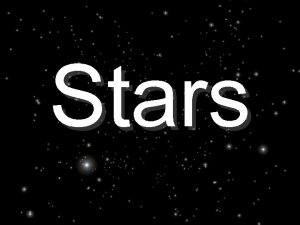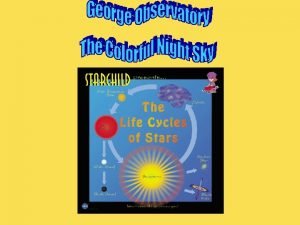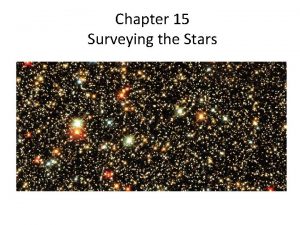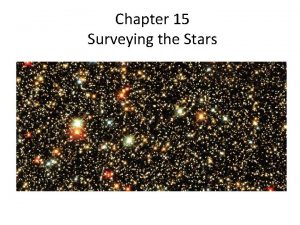11 1 Stars A star is a massive






- Slides: 6

11. 1 Stars • A star is a massive sphere of gases with a core like a thermonuclear reactor. • The most common celestial bodies in the universe are stars. • It is estimated there are more stars in the universe than there are grains of sand on all the beaches on Earth. • By peering through the interstellar matter (dust and gases), astronomers an observe the birth of stars. See pages 368 - 369 (c) Mc. Graw Hill Ryerson 2007

The Birth and Life of Stars • Stars form from the dust and gases found in a nebula, when enough gravity causes all the molecules to collapse in on themselves. • If enough matter gathers, the gravity becomes so massive that hydrogen atoms join to form helium atoms, producing huge amounts of energy through the process of fusion. • It is the energy given off by fusion that causes stars to glow. • The life cycle of a star: nebula, low mass star, intermediate mass star (like our Sun), high mass star. Large high mass stars often explode as supernovas, spreading elements throughout the universe. See pages 370 - 371 (c) Mc. Graw Hill Ryerson 2007

• Stars 12 - 15 times more massive than our Sun can end as neutron stars after going supernova. These superheated, super massive dead stars can take trillions of years to cool. • Stars 25 times as massive as our Sun can become black holes instead of neutron stars. The same process that produces a neutron star produces an area so massive and yet so small that the gravity it produces traps everything - even light! • Stars can vary greatly in size. Although our Sun is an average size, many of the stars we see in the night sky are up to 3000 times as large as the Sun. See pages 372 - 373 (c) Mc. Graw Hill Ryerson 2007

The Hertzsprung-Russell Diagram • By studying stars, astronomers have created an evolutionary ‘lifespan’ that stars progress through. • • The Hertzsprung-Russell diagram was developed to show the different stages of a star’s life. 90% of stars are in the main sequence, where energy is produced combining hydrogen atoms into helium. Blue Red See page 374 (c) Mc. Graw Hill Ryerson 2007

Analyzing Star Colour • The colour of a star reveals its temperature and composition to astronomers. • Red stars = cool = 3000 ºC Yellow stars = hot = 6000 ºC Blue stars = hottest = 20 000 ºC - 35 000 ºC • Using a spectroscope, the light emitting from a star reveals spectral bands that show certain gases in the star. • Of course, spectral lines are also used to identify the movement of stars by utilizing red-shift analysis. • Red-shift is an example of the Doppler effect, which states that as a wave-emitting object moves, the wavelength of its waves change. See pages 374 - 375 (c) Mc. Graw Hill Ryerson 2007

Colour and Motion • The Doppler effect refers to the way waves either compress as their source gets closer, or lengthen as the source gets farther away. • The unique spectral pattern each star reveals when examined through a spectroscope allows astronomers to see if the lines shift towards the red part of the spectrum (moving away) or blue (moving closer). Take the Section 11. 1 Quiz (c) Mc. Graw Hill Ryerson 2007 See pages 376 - 377











